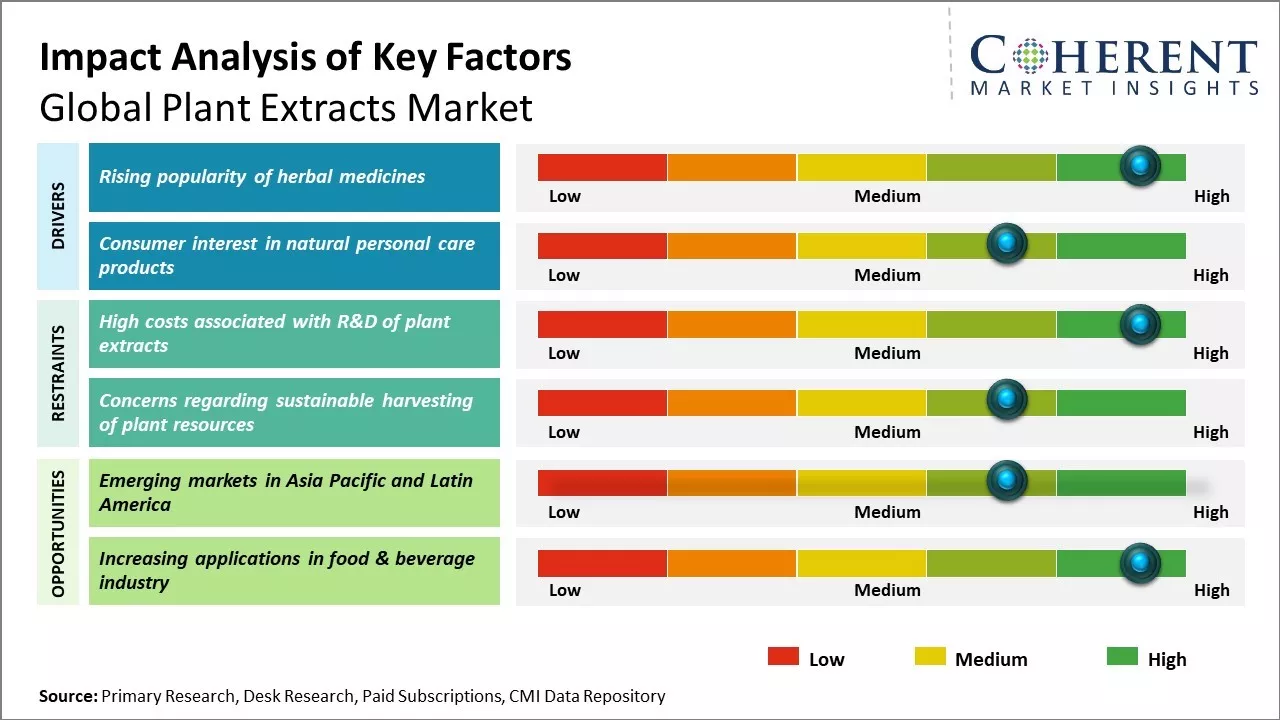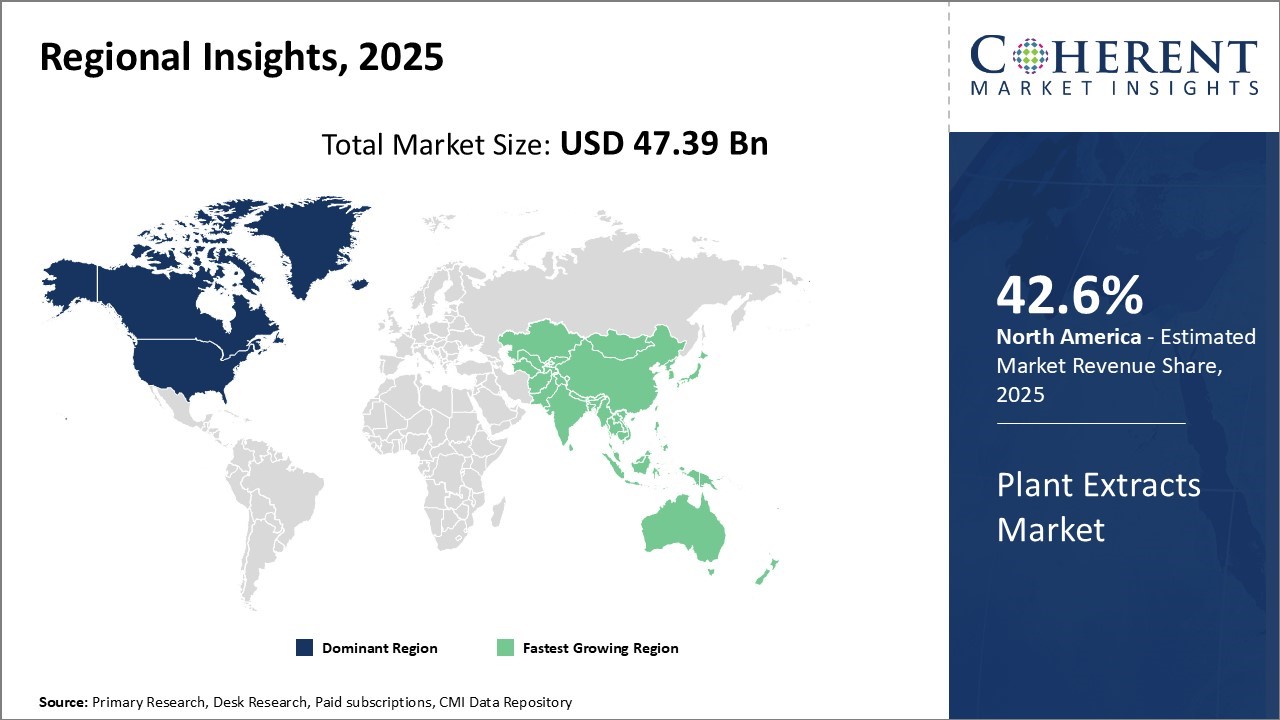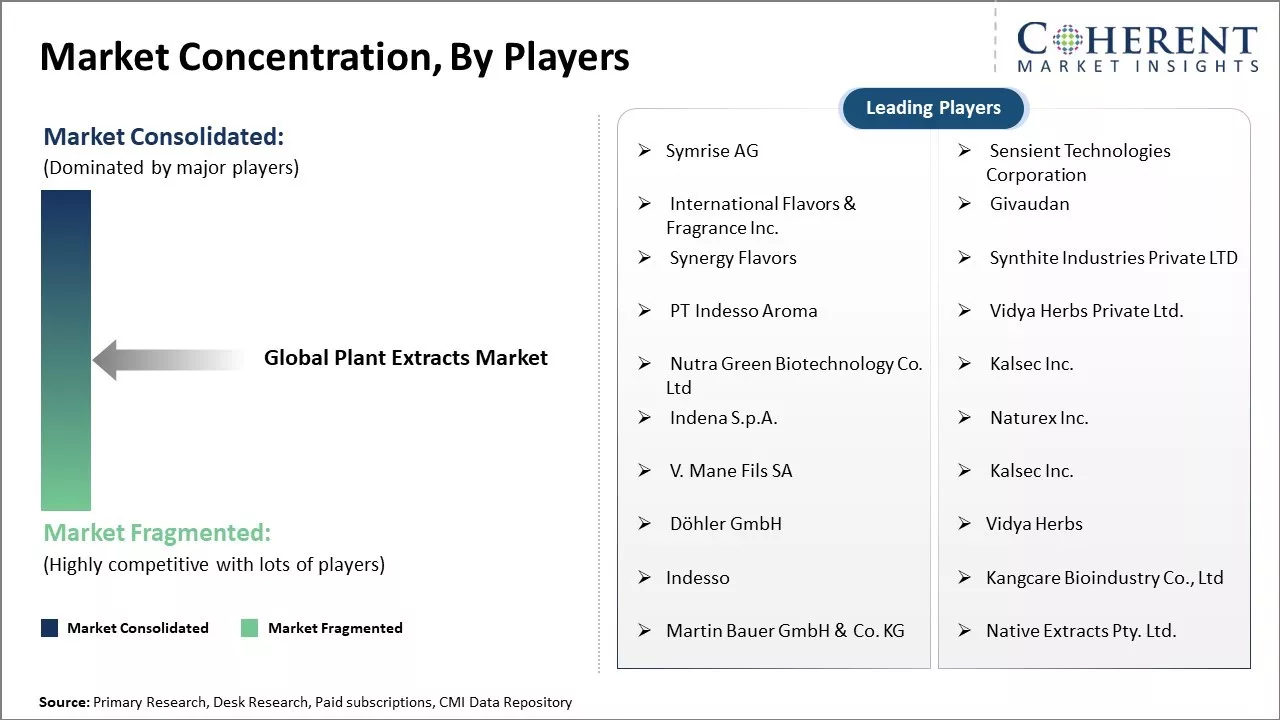Plant Extracts Market is estimated to be valued at USD 47.39 Bn in 2025 and is expected to reach USD 100.97 Bn in 2032, exhibiting a compound annual growth rate (CAGR) of 11.4% from 2025 to 2032.

To learn more about this report, Download Free Sample
The plant extracts market size is growing health consciousness, a preference for clean-label products, and a move away from artificial ingredients are all factors. The global plant extracts market is expected to witness strong growth over the forecast period. The rising demand for natural ingredients from industries such as pharmaceuticals, functional food & beverages, and premium cosmetics is expected to drive the growth of the market. Growing awareness regarding the health benefits of plant extracts along with the increasing consumer preference for herbal and natural products are further expected to support the increasing demand. Moreover, the expanding application scope of plant extracts in nutraceuticals, skincare and emerging industries such as cannabis is projected to create new opportunities for players in the market.
|
Event |
Description and Impact |
|
Surge in Clean-Label and Natural Product Demand |
|
|
Adoption of AI and Machine Learning in Automation |
|
Uncover macros and micros vetted on 75+ parameters: Get instant access to report
The pricing of plant extracts in Europe is influenced by several factors, including the quality and purity of the extracts, the type of plant source, extraction methods, and regional demand. This is particularly relevant in the anti-aging creams with plant extracts market, where European products, especially those from Germany and Switzerland, command premium prices due to their reputation for high quality and stringent quality control standards.
Additionally, the growing demand for plant extracts in pharmaceuticals, food, and cosmetics has led to increased competition, which can both stabilize and drive up prices depending on supply dynamics and raw material availability. Fluctuations in the supply chain, especially for rare or seasonal botanicals, can also lead to price volatility, impacting both manufacturers and end-users.
In terms of product type, essential oils is expected to contribute 36.9% share of the market in 2025, owing to the growing consumer preference for natural products. As people become more health conscious, they are drawn to essential oils due to their numerous benefits and lack of synthetic chemicals.
Compared to other plant extracts, essential oils offer a more concentrated format that packs the therapeutic essence of plant ingredients into small volumes. This has made them highly sought after as natural alternatives in various applications. Their use in aromatherapy and alternative medicine is also gaining wider acceptance, further spurring demand. In the personal care space, essential oils are prominent ingredients in many natural cosmetic products for their skin and hair benefits.
Food and beverage producers also incorporate essential oils to impart distinctive flavors in a natural way. Overall, the diverse applications and natural positioning of essential oils have enabled this segment to outperform others in the plant extracts market. Looking ahead, as consumers increasingly prioritize wellness and sustainability, essential oils are poised to retain their top status.
In terms of form, the dry segment is expected to hold 68.3% of the market share in 2025, driven by its stability advantages. Being concentrated makes dry plant extracts more shelf-stable than liquids, enabling easier storage and transportation. This durability is highly valued across different industries where plant extracts are utilized.
Pharmaceutical companies prefer dry formulations as they maintain consistent potency over extended periods. Likewise, food producers favor dry plant extracts for their ability to withstand packaging, distribution and storage without degradation. In personal care, dry extracts also offer formulation benefits as their concentration allows for precise inclusion in small volume products like serums and creams. Their non-perishable nature further ensures minimal wastage.
Overall, as industries require plant-based compounds to retain quality and efficacy over time, the superior stability of dry extracts has made them the preferred format in the plant extracts marketplace.
In terms of application, personal care is expected to emerge as the leading segment in the plant extracts market with 38.1% of the market share in 2025. Growing consumer emphasis on natural ingredients is a key factor driving the use of plant extracts in personal care products. People are increasingly seeking natural alternatives to synthetic chemicals in their skin, hair, and oral care regimes.
Plant extracts deliver multiple bioactive compounds that contribute various benefits. For instance, phytochemicals from fruits and herbs are popular anti-aging actives. Essential oils provide therapeutic scalp and skincare effects. Natural extracts also allow formulation of products aligned with clean beauty trends. Manufacturers utilize plant extracts to market premium natural positioning and better ingredient labels.
Additionally, continuous new product launches incorporating plant-based compounds have augmented their application in personal care. The dynamic nature of the personal care industry strategizing on trending consumer interests makes it a fertile ground for plant extracts. Overall, personal care emerges as the top application driving the overall plant extracts marketplace.

To learn more about this report, Download Free Sample
North America has emerged as the dominant region in the global plant extracts market. The region is expected to account for 42.6% of the market share in 2025. The large size and robust growth of the nutraceuticals industry in the U.S. and Canada has propelled the demand for various plant extracts.
Rising health consciousness among consumers has increased the consumption of dietary supplements, which is the major end-use segment for plant extracts. Furthermore, the presence of leading players such as Frutarom, Naturex, Sensient Technologies, and numerous small and mid-sized firms has made North America a major innovation hub in this industry.
These companies cater to the demands of various healthcare products and food & beverage brands. Given the strong production capabilities and distribution networks of extract manufacturers across the region, North American brands can source high quality plant extracts with ease and reliability.
The Asia Pacific region displays the fastest growth prospects for the plant extracts market over the forecast period. Rapid economic development, rising disposable incomes, and growing health awareness are some key macroeconomic factors driving the market growth. Countries like India and China consist of nearly 40.5% of the world's population and their collective GDP is expected to surpass major developed economies in the coming years. This indicates the immense commercial potential of catering to their domestic needs.
Local companies in Asia Pacific are investing in R&D facilities to develop innovative extraction technologies and novel plant-based products. They also increasingly partner or acquire foreign extract manufacturers to gain access to advanced methods and new plant varieties.
Various trade agreements have further eased the import of plant extracts within the region. Such favorable market environment and demand drivers are assisting the rise of Asia Pacific as the fastest expanding regional market for plant extracts.
The market for plant extracts in Europe is expected to keep growing due to consumer preferences, technical advancements, and robust demand from a wide range of application sectors. The quality and purity of European goods, particularly those from Germany and Switzerland, are highly prized, which increases demand for them both domestically and internationally.
Strong consumer demand for natural and clean-label products in the food, beverage, pharmaceutical, cosmetic, and nutraceutical industries is driving the U.S. industry. Manufacturers are being pushed to create pure and potent plant extracts by American consumers' strong preference for products with few artificial additives.
India's extensive production of medicinal plants, ancient Ayurvedic knowledge, and rich biodiversity make it stand out in the market for plant extracts. The nation is a major supplier of a variety of botanical extracts, particularly for usage in cosmetics, nutraceuticals, and pharmaceuticals. India is becoming a major exporter because to the rising demand for natural health products and the expanding acceptability of traditional herbal therapies around the world.
The nation enjoys the advantages of a vast manufacturing base, a wealth of raw material resources, and a long history of using plant-based substances in food and medicine. China's demand for botanical extracts is being driven by the country's fast urbanization, rising disposable income, and consumer desire for functional, healthful meals.
| Report Coverage | Details | ||
|---|---|---|---|
| Base Year: | 2024 | Market Size in 2025: | USD 47.39 Bn |
| Historical Data for: | 2020 To 2024 | Forecast Period: | 2025 To 2032 |
| Forecast Period 2025 to 2032 CAGR: | 11.4% | 2032 Value Projection: | USD 100.97 Bn |
| Geographies covered: |
|
||
| Segments covered: |
|
||
| Companies covered: |
Symrise AG, Sensient Technologies Corporation, International Flavors & Fragrance Inc., Givaudan, Synergy Flavors, Synthite Industries Private LTD, PT Indesso Aroma, Vidya Herbs Private Ltd., Nutra Green Biotechnology Co. Ltd, Kalsec Inc., Indena S.p.A., Naturex Inc., V. Mane Fils SA, Kalsec Inc., Döhler GmbH, Vidya Herbs , Indesso , Kangcare Bioindustry Co., Ltd, Martin Bauer GmbH & Co. KG, Native Extracts Pty. Ltd. are the major players |
||
| Growth Drivers: |
|
||
| Restraints & Challenges: |
|
||
Uncover macros and micros vetted on 75+ parameters: Get instant access to report

To learn more about this report, Download Free Sample
The use of plant extracts in herbal medicines is growing globally due to the increasing concerns about the potential side effects of synthetic drugs. Many people now prefer taking herbal remedies made from plant extracts to treat common health issues like cough, cold, digestive problems, etc. as they believe that natural remedies are safer and more effective than allopathic medicines.
Various plant extracts like ginger, turmeric, garlic, aloe vera, basil, etc. have been used extensively in Ayurveda and Chinese traditional medicines for centuries to treat numerous ailments without any major side effects. With growing evidence of their healing properties, herbal medicines are gaining more trust among the public.
More people are now turning to herbal supplements containing various plant extracts to boost their immunity, energy levels and overall well-being in a natural way. The elderly population in particular favors herbal medicines to avoid health complications associated with prolonged usage of synthetic drugs. Herbal remedies are also becoming increasingly popular as an alternative to painkillers and anti-depressants.
Many Ayurvedic and Chinese medicines use plant extracts like ashwagandha, tulsi, shatavari, ginseng, etc. to fight stress and infections in a natural manner without any side effects. Manufacturers are developing more efficacious herbal formulations containing standardized extracts from these medicinal plants to capitalize on the rising preference for natural remedies.
Rising health and environmental concerns have prompted many consumers to look for natural and sustainable personal care products containing plant extracts. People are increasingly wary of chemicals in cosmetics and want to switch to formulations containing botanical extracts that are gentler on the skin as well as the environment.
With growing research supporting the skin healing and anti-ageing properties of various plant extracts, there is soaring demand for natural beauty products incorporating these natural ingredients.
Manufacturers are actively responding to this consumer sentiment by launching more green personal care ranges containing extracts from fruits and plants that are rich in antioxidants. Some of the most popular botanical extracts finding applications in natural skin, hair and oral care products include aloe vera, green tea, pomegranate, grapeseed, jojoba, calendula, neem, ginger, turmeric, etc.
The research and development required to discover and verify the medical applications of plant extracts is an extremely expensive and lengthy process. Pharmaceutical companies must invest significant resources into conducting laboratory and clinical testing to study how plant compounds may treat or prevent diseases. Often, many plant extracts do not end up having useful medical properties or their effects are too minor to justify developing into drugs.
According to data from the World Health Organization, nearly 80% of plant extracts that enter the preclinical trial phase will never make it to human testing due to insufficient efficacy, unacceptable toxicity levels, or other safety issues. The vast sums required for unsuccessful research projects acts as a deterrent for companies and restricts further investment in exploring nature's pharmacopeia of potential treatments.
The plant extracts market is witnessing several prominent trends that are shaping its rapid growth and evolution. There is a strong and growing demand for natural and clean-label ingredients across food, beverage, cosmetics, and pharmaceutical industries, as consumers increasingly seek products with health benefits, minimal synthetic additives, and transparent labelling. This consumer preference is fueling the integration of plant extracts into functional foods, dietary supplements, and personal care products, with particular interest in botanicals that offer antioxidant, immune-boosting, and anti-inflammatory properties.
The Plant Extracts Market in Herbal Teas is also expanding rapidly, as consumers turn to herbal infusions for their perceived wellness benefits and natural flavors, further driving innovation and product development within the segment.
The plant extracts market in emerging economies of Asia Pacific and Latin America promises significant growth opportunities going forward. These regions are home to a diversity of native plant species that have historically formed the basis of traditional medicine systems. With growing global interest in herbal supplements and natural ingredients, plant-based therapies from these regions are gaining more mainstream acceptance.
Countries such as India, China, Brazil, and Mexico have a strong cultural emphasis on herbal remedies and medicinal plants. For example, according to the World Health Organization (WHO), around 80% of the Indian population still relies on traditional Ayurvedic and herbal medicine. There has also been a steady rise in upper- and middle-class populations in these developing nations who are more aware of natural ingredients and their health benefits.
Local companies are increasingly investing in extraction technologies to derive active pharmaceutical ingredients from indigenous plants. They aim to develop standardized herbal formulations for export markets, in line with international regulatory standards.
*Definition: Plant Extracts are concentrated substances obtained by using solvents to dissolve and separate soluble components from botanical materials such as roots, leaves, flowers, seeds, or fruits. These extracts are complex mixtures containing various bioactive compounds including flavonoids, phenols, terpenes, alkaloids, and other phytochemicals that contribute to their therapeutic, nutritional, or functional properties.
Share
Share
About Author
Pankaj Poddar is a seasoned market research consultant with over 12 years of extensive experience in the fast-moving consumer goods (FMCG) and plastics material industries. He holds a Master’s degree in Business Administration with specialization in Marketing from Nirma University, one of India’s reputed institutions, which has equipped him with a solid foundation in strategic marketing and consumer behavior.
As a Senior Consultant at CMI for the past three years, he has been instrumental in harnessing his comprehensive understanding of market dynamics to provide our clients with actionable insights and strategic guidance. Throughout his career, He has developed a robust expertise in several key areas, including market estimation, competitive analysis, and the identification of emerging industry trends. His approach is grounded in a commitment to understanding client needs thoroughly and fostering collaborative relationships. His dedication to excellence and innovation solidifies his role as a trusted advisor in the ever-evolving landscape of not only FMCG but also chemicals and materials markets.
Missing comfort of reading report in your local language? Find your preferred language :
Transform your Strategy with Exclusive Trending Reports :
Frequently Asked Questions
Joining thousands of companies around the world committed to making the Excellent Business Solutions.
View All Our Clients